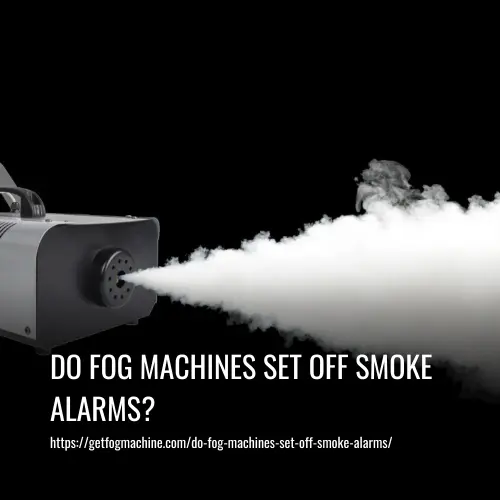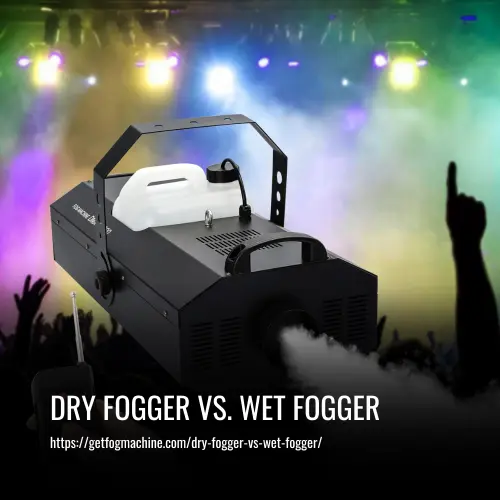Fog machines are a popular choice for creating an eerie atmosphere during Halloween or theatrical performances. However, like any equipment, they may encounter issues that prevent them from producing fog. In this guide, we will discuss some common troubleshooting steps to help you get your fog machine up and running again.

1. Check the Pump
The pump is responsible for moving the fog fluid from the tank to the heat exchanger. If you don’t see any fog, ensure that the fluid tank isn’t empty. If the pump is making a humming sound, it is likely working, but there may be blockages. To clear blockages, consider running distilled white vinegar through the system or check for kinked hoses. If the pump isn’t working at all, you may need to replace it.
2. Inspect the Heat Exchanger
The heat exchanger heats the fog fluid and transforms it into vapor. Ensure that the heating element inside the metal block is functioning correctly. If the fog machine’s wattage is too low, it may struggle to maintain the required heat. You may need to purchase a fog machine with higher wattage for better performance.
3. Examine the Nozzle
The nozzle dispenses the superheated fog vapor. If the nozzle or its protective cover becomes extremely hot during use, allow them to cool down before attempting any repairs. Make sure the exit nozzle isn’t clogged or blocked, as this may hinder fog production.
By following these troubleshooting steps, you can address common issues with your fog machine. Regular maintenance, such as cleaning and using fog machine cleaner, can help prevent problems. Remember to consult the manufacturer’s instructions or seek professional assistance if the issue persists.
What To Do When Fog Machine Pump Not Working
When your fog machine pump is not working, it can be frustrating. However, there are some steps you can take to troubleshoot and fix the issue. Here we will discuss how to fix a dirty and clogged pump, as well as how to address a worn-out pump in a fog machine.
Fixing a Dirty and Clogged Fog Machine Pump
When your fog machine is not working and you can hear the pump running but no fog is coming out, the issue may be a clogged pump. Here are four easy steps to unclog and clean your fog machine pump.
Step 1: Open and Remove the Cover of the Pump: To access the pump, unscrew the screws along the side of the fog machine case and lift off the cover. Once the cover is removed, you will be able to see the inner workings of the machine, including the pump and the sensors for the heater block.
Step 2: Check the Nozzle and Unclog the Pinhole: Often, clogged pumps are caused by blocked nozzles. Remove the rubber bracket holding the fog machine together and use a wrench to check if the nozzle is loose. Disassemble the device to reveal the pinhole that is causing the clog. Unclog it by poking it with a needle on both sides and soaking it in hot distilled water for a few minutes. Blow through it to ensure air flow.
Step 3: Open the Interior of the Pump: If the clog persists, remove the two screws from the cylindrical pump assembly. Check the coil inside the pump for any issues. Remove the small key groove, ensuring nothing is lost.
Step 4: Disassemble and Clean the Pumping System: Once the seal is removed, you will see the pump mechanism that moves the fog fluid. Disconnect and soak the metal component in distilled water. Tap the screen to make the small ball fall out and secure it. Remove the plastic piece and spring. Soak all the disassembled parts in cleaning solution before reinstalling them.
Fixing a Worn Out Pump in a Fog Pump Machine
When your fog machine is not working properly, one possible issue could be a worn-out pump. The pump is responsible for pumping the fog fluid from the reservoir into the heating element. If you suspect that the pump is the problem, you can follow these simple steps to fix it.
Step 1: Dismantling the Worn Out Pump: The first step is to remove the pump from the fog machine system. Disconnect the back nut attached to the output side of the pump. Cut the wires on the input side of the pump and remove the plugin for the reservoir.
Step 2: Find Materials for Repairing the Pump: Locate the necessary materials from your local hardware or auto parts store. Consider using a windshield washer pump or any other motor with a voltage difference similar to the fog machine. The intention is to correct the output voltage using a transformer.
Step 3: Correct the Output Voltage Using a Transformer: Use a transformer to convert the 120-volt alternating current from your home to 12 volts. Feed the converted voltage through a bridge rectifier to convert it to direct current. Consider replacing the circuit board if necessary.
Step 4: Modify the Pump: Connect the modified pump using a barbed fitting and tubing. Drill a hole and insert the adapter to connect the pump to the heating element of the fog machine. Secure the fittings and attachments properly.
Step 5: Design an Adapter: Tap the barbed fitting into the pump with a rubber mallet and connect the adapter to the pipe. Leave a knot in the tube to secure the compression fitting.
Step 6: Connect the Transformer to the Modified Pump: Establish a tube connection between the old and new pumps. Wire the transformer to hack the pump and replace it with the new one. Connect the output to a rectifier to reduce the voltage to 12 volts DC.
Step 7: Mount the Pump on the Fog Machine: Mount the electrical connections and transformer in empty spots within the fog machine. Use a voltage meter to ensure the correct voltage. Install the reservoir tank and test the pump motor.
When the Fog Machine Makes a Loud Noise
When the fog machine makes a loud noise, it could be due to the dispersion of fog, which is a normal trait in many fog machines. This noise is caused by the forceful release of vapor, especially in higher wattage models with greater output distances.
However, if the noise is accompanied by a chunking sound and a drastic drop or lack of fog emission, it may indicate a failing pump. In such cases, it is important to exercise caution when attempting to fix the pump, as it could void the warranty or worsen the situation. Consider reaching out to the manufacturer or nearest service center for assistance.
If the noise is simply a result of the machine’s design or power, you can try placing it further away from the action, blocking it with decoration, or even building a containment unit, while ensuring the nozzle path remains clear to prevent overheating.
FAQs
There could be several reasons why your fog machine is not working. Firstly, check if the power supply is connected properly and the machine is switched on. Ensure that the fog fluid level is sufficient. If the machine has been idle for an extended period, the heater block may require a longer warm-up time. Additionally, inspect the pump motor and the heating element for any faults or damage.
To get your fog machine working again, start by checking the power source and making sure the machine is turned on. Verify that the fog fluid is not empty and replace it if necessary. Perform regular maintenance, such as cleaning the machine and unclogging the pump. If the issue persists, consider examining the pump motor or replacing it if needed.
Cleaning a clogged fog machine involves using a cleaning solution, such as a mixture of white vinegar and water. Detach the pump assembly and clean it thoroughly, using a brush or a cloth to remove any debris or residue. Clean the pump tube and fluid bottle as well. After cleaning, reassemble the fog machine, fill it with fresh fog fluid, and let it run for a couple of minutes to ensure proper functioning.
Yes, fog machines generally have fuses to protect the internal components from electrical issues. If your fog machine is not working, check the fuse to see if it has blown. If so, replace it with the appropriate type and rating, usually a heat or ceramic fuse.
Yes, fog machines can overheat if used continuously for an extended period. To prevent overheating, ensure the machine has proper ventilation, and follow the manufacturer’s guidelines regarding the recommended operating time. If the fog machine overheats, it may automatically shut off or require a cool-down period before being used again.
Fog machine fluid does have a shelf life and can go bad if not properly stored. Unopened fog fluid bottles can generally last for several years. However, once opened, the fluid should be used within a specific period mentioned on the bottle. If the fog fluid appears discolored or has a strong odor, it is recommended to replace it with fresh fluid for optimal performance.
Fog machines require a specific fog machine fluid or fog juice, which is specially formulated for this purpose. It is essential to use the recommended fluid to maintain the machine’s functionality and prevent clogs. Avoid using any other liquids, such as water or oil-based solutions, as they can damage the machine and may not produce the desired fog effect.
The lifespan of a fog machine can vary depending on the brand, model, and usage. Generally, a well-maintained fog machine can last for several years with regular maintenance and proper care. However, like any electronic device, it may require occasional repairs or replacement of certain parts over time.
Conclusion
In conclusion, when your fog machine is not working, there are a few steps you can take to troubleshoot and fix the issue. First, check the power supply and ensure that it is properly connected and providing electricity to the machine. Next, inspect the heater block and the heating element to make sure they are functioning correctly. If necessary, replace the faulty parts.
Another common problem is a clogged pump. To address this, try cleaning the pump motor with white vinegar or a commercial fog machine cleaner. Run the machine for a couple of minutes with the cleaning solution to remove any debris or build-up. If the pump is still not working, it may need to be replaced.
Regular maintenance is important to prevent issues with your fog machine. Clean the fluid tube, fluid bottle, and pump assembly regularly to avoid clogs. Also, check the heat fuse and amp fuse to ensure they are not blown. If they are, replace them with the correct type of fuse.
Remember to always refer to the manufacturer’s instructions for your specific fog machine model. If the problem persists or you are unsure about any repairs, it is recommended to consult a professional technician or contact the manufacturer for assistance.




